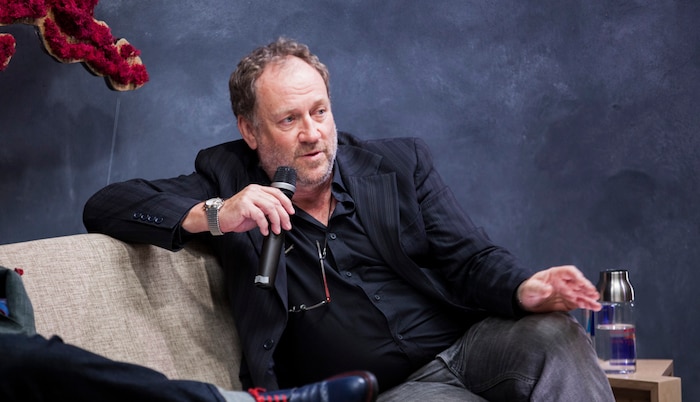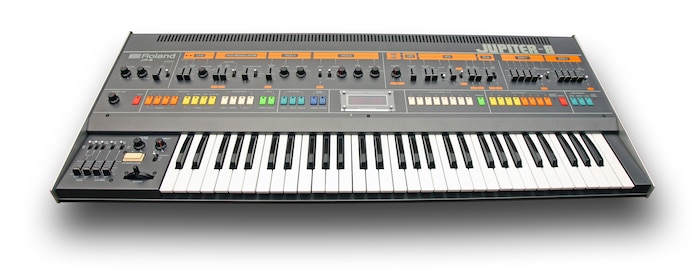Harold Faltermeyer’s Favorite Synths

Harold Faltermeyer dominated the ’80s by composing two of the most enduring pieces of movie-inspired synth madness: “Axel F” (the theme to Beverly Hills Cop) and the “Top Gun Anthem.” When he wasn’t soundtracking your favorite cop car and fighter jet chases, Harold Faltermeyer was Giorgio Moroder’s right-hand man, arranging and producing for the likes of Donna Summer, Cheap Trick, and the Pet Shop Boys. Faltermeyer stopped by the Academy last year in Tokyo for a lecture, so we took the opportunity to hear more about his favorite studio toys – and why he loves them.

Roland Jupiter-8
When the Roland Jupiter-8 first came out, it was the most desired instrument on earth – so, needless to say, you couldn’t get it. There was a waiting list for it. We had a very good relationship with Roland, though, due to the fact that I worked with Jeff Baxter from the Doobie Brothers. He was under contract with them, so he had access to the instruments. He put in a word, you know, so I definitely got a deal.
At that time, the instrument was rather expensive already – like, $8,000 dollars or something like that. But it was the first one to have eight voices. This was a big step towards new sounds, new creations – new everything. The Jupiter-8’s particular sound comes from the structure of the two oscillators of each bank – of each voice – so you can actually layer them. This makes for a very fat, good sound. The Jupiter-8 was my main instrument for melodies – all the “Axel F” melodies were made on it.
With the Jupiter-8, you had this crossfeed button where you could force the one oscillator to work with another, and then detune it all to give you absolutely unique images, you know? For example, for the introduction of “The Heat Is On” by Glenn Frey, there’s a sort-of cuckoo-sounding image at the beginning, which was made with a single Jupiter 8 sound. We had it stored once and we tried to reload the tape, but the tape was broken and so we never got the sound back. I would have got multi tracks and sampled it, if I’d known then what I know now.
You had the possibility to use a pedal for the filters, so you could tweak the sound very uniquely. It was a very melodic, dynamic way of playing pads, rather than just raising the volume or diminishing the volume. Although, as you might know, there was this encoding system: 4-2-4 by Dolby. This machine could play some nasty tricks on you. It just wiped out things, which were somehow not in phase or were in phase. We were always trying to fool the box.
Roland System 700
With the Roland 700 stuff, you always had to tune it. I went crazy with the setup we had for the Giorgio Moroder album, E=MC². We had four of those systems, so before you started, you had to tune it. We’re talking about 32 oscillators, all of which had to be tuned and detuned. Because you’re putting them slightly out of tune to create a certain sound, it was hard as hell.
Of course, these instruments go through various “renaissances.” Sometimes you say, “I don’t use it now, it’s outdated.” Then, all of a sudden, you run into a production, or you hear something amazing and say, “You guys must have used that particular kind of synthesizer.” And then you start digging them out again. You say, “Let me just try...” and then you find out again what a great instrument it is.
Roland JX-3P
The other synthesizer I have and love is the Roland JX-3P. That’s the instrument that the Fletch scene was played on. It’s actually a preset sound, like a sync sound. It’s slightly modified, but it’s unmistakable. We were really glad that, all of a sudden, we could have preset sounds. Before then, we were creating sounds on a daily basis and we had to record as many of them as possible. Sometimes it was a really annoying process, trying to “get a sound back.” (Giorgio Moroder would always say, “You know, we had this great sound back then.”) This was way before today’s possibilities of sampling. “Can’t we just have this sound? Well, we have to recreate it.”
It was a great development to have preset sounds. They have another beauty to them – your creativity. When you compose, or when you start trying to compose, I found that I started to become very sound dependent. When I hit a certain sound, it triggered a melody in my head. I got rather creative with melodies because of it – stepping through hundreds of sounds and playing a little melody from them.
Aside from the presets, the Roland JX had a very unique sound. Roland, then, had a VCO that wasn’t very normal for the time. It was a kind-of modular set-up that had lots of controls in the VCO already. The possibilities of modifying, syncing and overdriving with this one unit were endless. This was the unique beauty of Roland.
Yamaha DX7
The DX7 was another synthesizer that was very hard to get. The first ones we got were from Japan, so we had to have an energy converter for it! I unpacked it, tried it out, and said, “Well, nice toy…” It seemed very complicated to program, with all those parameters.
Very early on, I found that the only beauty of a DX7 is when you have two DX7’s. Then the TX816 came along, which had eight DX7’s in it. This was a heavenly instrument because you could slightly change parameters on each voice. You could daisy chain them. I had two of those, so the low bell sounds in Top Gun, for example, are 16 DX7’s. That’s actually a stock sound. It’s a tubular bell, just slightly detuned and tweaked. We had this extreme, fat low C. That’s how the Top Gun anthem starts.
...and more
Some instruments were like real underdogs, but the Linn synthesizer was never an underdog. The Linn was like, “Wow, now you have a real drummer playing in a really tight way for you.” The kick is a tight, four on the floor kick. The only thing that was always a bitch with the Linn was the snare, which was always delayed. We would put a delay on the kick for a few milliseconds and start the machine later. You could justify exactly where you want to have the snare at that time. That’s how we made the beats sound tight.
If you add up all the time you spend trying to make a machine sound like an orchestra, it’s not that much more expensive.
For me, the Moog modular synthesizer is the best for bass. I bought it in 1978 and I still use it. I wish I had have bought more of them. It’s more or less impossible, though. You have to pay a fortune. It’s the warmest, fattest bass sound you can ever get. It’s always in tune. Its structure and craftsmanship is just brilliant. It’s a piece of art.
In terms of what synthesizers I use right now, I still go back to the Roland 700 series, especially for the dephaser and flanger elements. They are incomparable with any sound you find in any library. The last time I used the Jupiter-8 was for the remake of “Axel F,” and sometimes I use the DX7 for slow bells, but beyond that, everything else is on the shelf. I’m using big libraries now.
Now, I’m not working too much on orchestral-sounding material. If I need orchestral sounds, I’ll go and record an orchestra: not only does it sound better, but if you add up all the time you spend trying to make a machine sound like an orchestra, it’s not that much more expensive. Sometimes the beauty of having both is good, though. I recently recorded a 60-piece orchestra and… it’s just a dream when you have good players, you know?

